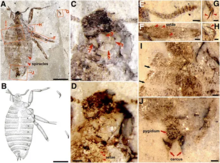| Pseudopulex Temporal range: Middle Jurassic to Early Cretaceous, 165–125 Ma PreꞒ Ꞓ O S D C P T J K Pg N | |
|---|---|

| |
| Pseudopulex wangi fossils | |
| Scientific classification | |
| Domain: | Eukaryota |
| Kingdom: | Animalia |
| Phylum: | Arthropoda |
| Class: | Insecta |
| Order: | Siphonaptera |
| Family: | †Pseudopulicidae |
| Genus: | †Pseudopulex Gao, Shih, and Ren, 2012 |
| Species | |
| |
Pseudopulex is an extinct genus of primitive fleas that lived between the Middle Jurassic and Early Cretaceous periods in what is now modern-day China. The Latin root for the name Pseudopulex roughly translates to "false fleas".
Taxonomy

There are currently four identified species in this genus that have been discovered through fossil remains: Pseudopulex jurassicus, Pseudopulex magnus, Pseudopulex wangi, and Pseudopulex tanlan. The majority of current research focuses on P. jurassicus and P. magnus.
Fossils of P. jurassicus date back to the middle Jurassic age of the Jiulongshan Formation in China, around 165 million years ago, while P. magnus was discovered from the Early Cretaceous Yixian Formation, around 125 million years ago. Potential hosts for P. jurassicus include Pedopenna daohugouensis or Epidexipteryx hui, while P. magnus may have parasitized Sinosauropteryx prima or Microraptor gui. These organisms have similar features to other studied ectoparasites and share traits with present-day fleas, most notably in their wingless bodies and long, sharp stylets that enabled them to pierce through thick skin and hide. They exhibit traits such as thinner, more elongated clawed appendages and extended mouthparts that can distinguish them from similar parasites such as lice. They have several traits that are different from extant crown group fleas which may be an indication of this genus possibly having an early evolution that resulted in a dead-end lineage. P. tanlan is considered to be a transitional organism between P. jurassicus or P. magnus and existing fleas as it has a smaller body plan, more compact antennae, and other features associated with extant fleas. Currently, there have been a total of six other flea-like fossils that have been discovered along with this genus.
Description

Pseudopulex species have flattened bodies, similar to common ectoparasites like ticks or bedbugs. However, between the species of Pseudopulex, there are distinct differences in morphology; P. jurassicus was slightly longer and contained a shorter stylet, while P. magnus was thicker and had very long mouthparts. P. tanlan was found to be smaller than other Pseudopulex species at about 10 mm long, with a relatively small head and thoracic cavity. The body of P. tanlan also exhibits very short and stiff setae. Compared to P. magnus and P. jurassicus, P. tanlan has relatively small male genitalia and short tibias in females. P. jurassicus was much larger, with a body length of 17 mm and a mouthpart length of 3.4 mm, which was twice the size of its head. This species had very small eyes, antennae, and a short torso covered in long thin bristles. Their legs were also quite long and each ended in a pair of long claws; however, unlike extant fleas, they lacked enlarged saltatorial hind legs. P. magnus was 22.8 mm long with 5.2 mm long mouthparts. Their heads were relatively small, and their bodies were compressed and stout compared to P. jurassicus. This species also exhibited antennae, dense setae, and claws on the ends of their legs, but had a distinctively large abdomen. P. wangi females were about 14.8mm long and had small heads, relatively short mouthparts, and short antennae. Males, however, were much smaller and had longer bodies with larger genitalia, indicating P. wangi was more sexually dimorphic than other species in its genus.
Paleobiology

Despite Pseudopulex having some similar characteristics to modern fleas, major differences in body morphology suggest differences in hosts compared to extant fleas. They possessed serrated stylets, which were likely used for feeding on blood through thick layers of skin, and are estimated to have been about fifty times larger than the dog flea. They may have later adapted to parasitizing smaller birds and mammals, altering their morphology to more closely resemble modern-day fleas.
References
- ^ Leung, Tommy (2015-08-29). "Parasite of the Day: Pseudopulex jurassicus". Parasite of the Day. Archived from the original on 2020-02-23. Retrieved 2020-03-02.
- ^ Gao, Taiping; Shih, Chungkun; Rasnitsyn, Alexandr P.; Xu, Xing; Wang, Shuo; Ren, Dong (2014-08-27). "The first flea with fully distended abdomen from the Early Cretaceous of China". BMC Evolutionary Biology. 14 (1): 168. Bibcode:2014BMCEE..14..168G. doi:10.1186/s12862-014-0168-1. ISSN 1471-2148. PMC 4154525. PMID 25158612.
- ^ Gao, Taiping; Shih, Chungkun; Rasnitsyn, Alexandr P.; Xu, Xing; Wang, Shuo; Ren, Dong (2013-07-08). "New Transitional Fleas from China Highlighting Diversity of Early Cretaceous Ectoparasitic Insects". Current Biology. 23 (13): 1261–1266. Bibcode:2013CBio...23.1261G. doi:10.1016/j.cub.2013.05.040. ISSN 0960-9822. PMID 23810530.
- ^ May 2012, Jeanna Bryner 02 (2 May 2012). "Monster 'Fleas' Put the Bite on Dinosaurs". livescience.com. Archived from the original on 2020-03-02. Retrieved 2020-03-02.
{{cite web}}: CS1 maint: numeric names: authors list (link) - ^ Gao, Tai-ping; Shih, Chung-kun; Xu, Xing; Wang, Shuo; Ren, Dong (2012-04-24). "Mid-Mesozoic Flea-like Ectoparasites of Feathered or Haired Vertebrates". Current Biology. 22 (8): 732–735. Bibcode:2012CBio...22..732G. doi:10.1016/j.cub.2012.03.012. ISSN 0960-9822. PMID 22445298.
- ^ Huang, DiYing; Engel, Michael S.; Cai, ChenYang; Nel, André (2013-05-01). "Mesozoic giant fleas from northeastern China (Siphonaptera): Taxonomy and implications for palaeodiversity". Chinese Science Bulletin. 58 (14): 1682–1690. Bibcode:2013ChSBu..58.1682H. doi:10.1007/s11434-013-5769-3. hdl:1808/14426. ISSN 1861-9541.
- ^ "Jurassic pain: Giant "flea-like" insects plagued dinosaurs". Life at OSU. 2012-05-01. Archived from the original on 2020-11-11. Retrieved 2020-03-02.
- May 2012, Jeanna Bryner 02 (2 May 2012). "Dinosaur Fleas! Photos of Paleo Pests". livescience.com. Archived from the original on 2020-03-02. Retrieved 2020-03-02.
{{cite web}}: CS1 maint: numeric names: authors list (link)
![]() Data related to Pseudopulex at Wikispecies
Data related to Pseudopulex at Wikispecies
| Taxon identifiers | |
|---|---|
| Pseudopulex | |